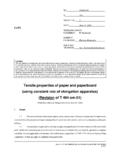Transcription of CHAPTER 9 SURVEYING TERMS AND ABBREVIATIONS
1 9-1 CHAPTER 9 SURVEYING TERMS AND ABBREVIATIONS SURVEYING TERMS 9-2 Standard ABBREVIATIONS 9-6 9-2 A) SURVEYING TERMS Accuracy - The degree of conformity with a standard, or the degree of perfection attained in a measurement. Accuracy relates to the quality of a result, and is distinguished from precision, which relates to the quality of the operation by which the result is obtained. Adjusted Position - An adjusted value for the horizontal or vertical position of a survey station, in which discrepancies due to errors in the observed data are removed.
2 This adjustment forms a coordinated and correlated system of stations. Bench Mark - A relatively permanent object, natural or artificial, bearing a marked point whose elevation above or below an adopted datum is known. Usually designated as a BM, such a mark is sometimes further qualified as a PBM (permanent bench mark), or as a TBM (temporary bench mark). Contour Line - An imaginary line on the ground, all points of which are at the same elevation above or below a specified datum.
3 Contour Interval - A predetermined difference in elevation (vertical distance) at which contour lines are drawn. The contour interval is usually the same for maps of the same scale. Contour Map - A map that portrays relief by means of contour lines. Control - A system of points whose relative positions have been determined from survey data. See: basic control, horizontal control, vertical control, and picture point. Control Point - A point whose position (horizontal or vertical) has been determined from survey data, and is used as a base for a dependent survey.
4 Control Station - A station whose position (horizontal or vertical) has been determined from survey data, and is used as a base for a dependent survey. Control Survey - A survey which provides positions (horizontal or vertical) of points to which supplementary surveys are adjusted. Coordinates - Linear or angular quantities, or both, which designate the position of a point in relation to a given reference frame. Correlate - To remove discrepancies that may exist among survey data, so that all parts are interrelated without apparent error.
5 The TERMS coordinate and correlate are usually applied to the harmonizing of surveys of adjacent areas or of different surveys to cover the same area. Two or more such surveys are coordinated when they are computed on the same datum; they are correlated when they are mutually adjusted. Data Collector - Electronic Field Notebook 9-3 A) SURVEYING TERMS (CONTINUED) Datum - A reference element such as a line or plane, in reference to which the positions of other elements are determined.
6 See: Horizontal Datum, Level Datum, and Vertical Datum. Discrepancy - (1) The difference between duplicate or comparable measures of a quantity. (2) The difference between computed values of a quantity obtained by different processes in the same survey. DTM, Digital Terrain Model - A representation in graphic form, on the computer, of the terrain through the area being surveyed. Easting - One of the two values indicating the position of a point on a grid system. The easting coordinate is abbreviated: E.
7 See: Grid Coordinates. Feature Codes The abbreviation used to define an object collected during a radial survey. Fixed Elevation - An elevation obtained, either as a result of tide observations or previous adjustment of leveling, which is held at its accepted value in any subsequent adjustment. Fixed Position - An adjusted value of the position of a point on the earth. The positions obtained by the adjustment are called adjusted positions, and when used as control for other survey work they are called fixed positions.
8 Grid - A network composed of two sets of equidistant parallel lines intersecting at right angles. Grid Azimuth - An azimuth measured from grid north. Grid Coordinates - The numbers of a coordinate system that designate a point on a grid. Grid Declination - The angular difference in direction between grid north and true north at any given place. Grid Distance - The straight line distance between two points, obtained by computations from their grid coordinates. Grid Position - The grid coordinates of a point.
9 Ground Control - In photomapping, control obtained from surveys as distinguished from control obtained by photogrammetric methods. Guard Stake- A stake driven near a point usually sloped with the top of the guard stake over the point. The guard stake protects, and its markings identify the point. Horizontal Control - Control stations whose grid coordinates are known. 9-4 A) SURVEYING TERMS (CONTINUED) Horizontal Datum - In plane SURVEYING , the grid system of reference used for the horizontal control of an area; defined by the easting and northing of one station in the area, and the azimuth from this selected station to an adjacent station.
10 Horizontal Position - The grid position of a horizontal control point. Hub - A wooden stake set in the ground, with a tack or other marker to indicate the exact position. A guard stake protects and identifies the hub. Latitude - (1) The angular distance north or south of the equator. (2) In plane SURVEYING , the amount that one end of a line is north or south of the other end. As the plane coordinates of a point are known as the easting and northing of the point, the latitude is the difference between the northings of the two ends of the line, which may be either plus or minus.

